There are two ditches most men seem to fall into when it comes to how they wear a tailored jacket. On one side are the large, oversized suits with sleeves and jacket too long and shoulders too wide, with pants sagging and drooping like they’re drapes. The other side is the super form-fitting, tight fit with bulging lapels, a short jacket length and very form-fitting pants. As with most things, somewhere in between these two is most ideal. Each aspect of how a jacket fits has a range of what could be considered a “good fit,” with personal preference and overall design aesthetic playing a part. In this post I want to give some basic principles for how a jacket should fit.
Shoulders: narrow or extended
This is one of the most critical aspects of jacket fit to get right, because altering it after the fact is essentially impossible. The shoulders of a jacket can be structured and padded, or soft and lightly or not padded; this depends on the design aesthetic and tailoring tradition (British suits are padded, Southern Italian ones are not). Since your body is three-dimensional, there are a few things that will impact how well a jacket fits you in the shoulders (such as how pronounced your deltoids are, etc.), but I’ll just talk about the width of the shoulders. In tailoring terms, the distance from the tip of the jacket’s shoulder, where the sleeve meets the shoulder at the top seam on one side to that same point on the other side, is called “point to point.”
Generally speaking, you want to avoid a jacket whose point-to-point measurement is so narrow that your arm juts out into the sleeve head (the top of the sleeve where it attaches to the shoulder). At the same time, if the point to point is so wide that the seam at the end of the shoulder sticks out far beyond your scapula (that bone at the tip of your shoulder right above your deltoid), drooping down, it’s too wide. So there is a range that can be considered well fitting.
Neapolitan tailoring tends to have a narrower shoulder, in part because Neapolitan jackets have very little in the way of structure, so a wider shoulder would just sag off the end of the shoulder. British and Northern Italian suits, with their padding and structured shoulder line, are often wider. But it’s not just about padding, it’s about design aesthetic, and tailors have tricks to get the jacket to do what they want. For instance, Florentine tailor Liverano, who typifies tailoring from his region, designs with an extended shoulder, yet does not utilize excessive padding for a structured look; he uses only what he needs to support the sleeve head, while still maintaining a softer, rounder look.
What looks most flattering on each person will be different depending on their specific anatomy, and your preferences will be personal as well. I prefer an extended shoulder, with a softer—but not totally rounded—look.
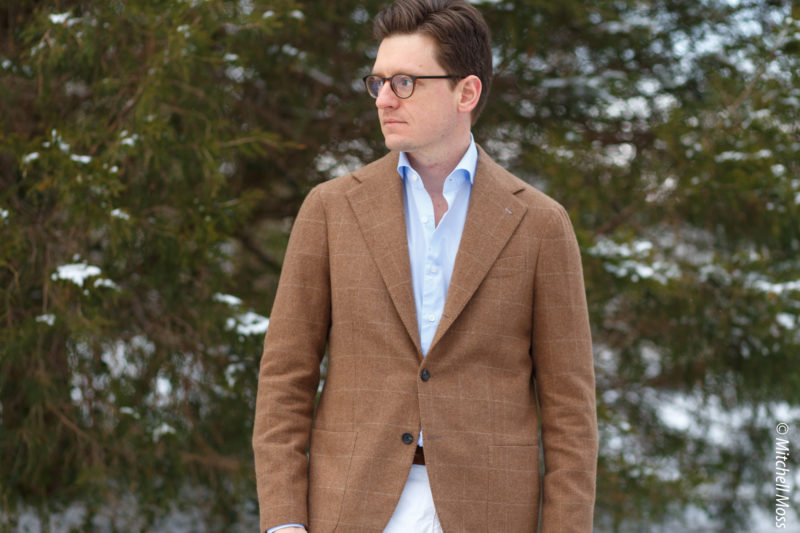
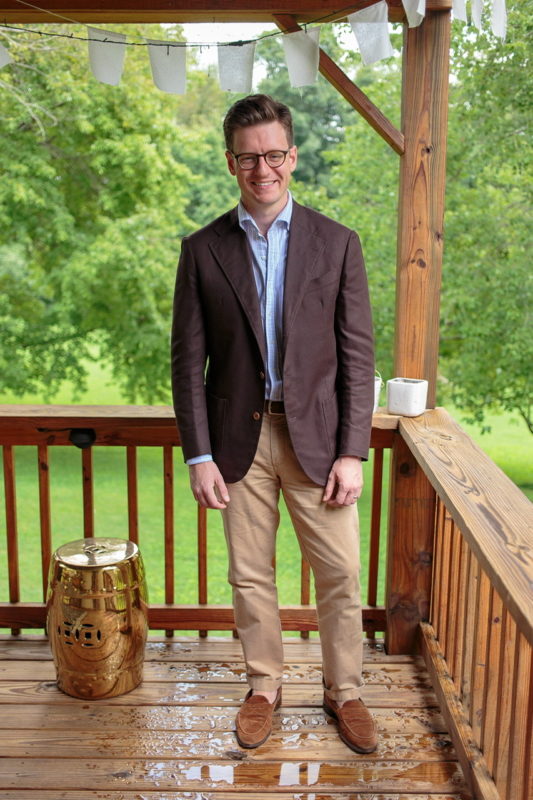
Chest fit: clean or with some drape
The chest of the jacket is also important to get right because alterations on it are expensive. A jacket’s chest should lay flat against the wearer’s chest, without the lapels bulging outward—that would indicate it is too tight. A chest that’s too big will have lots of extra fabric, and will probably also fit very loose in the upper back as well. The armholes will also probably be low on a jacket that’s too big in the chest, meaning the sleeves will be very loose, too, meaning that even if you had a tailor take the jacket in at the back seams and in the shoulder blades, the jacket would still look a little sloppy on account of the low armholes, big sleeves and loose chest.
There is a range of aesthetic choices, however, that can be made. A close-fitting, clean chest is the norm today. If you touch the jacket in the chest while someone is wearing it, the cloth is fitting cleanly against his body. On the other end of the spectrum is what’s called the “drape” cut, or the descendants of the drape cut, which is purposefully making the chest fit slightly large (without the typically attendant loose sleeves, low armholes and loose upper back) so that it accentuates the waist below.

Length
There are a few rules out there for how long a jacket should be, but the one that is most objective is that the jacket should fully cover your rear-end in the back, like in the image above.
[Related Read: An object lesson in jacket length]
A recent purchase of mine and how it’s caused me to re-evaluate my perceptions of what I feel is the ideal fit
I recently bought a navy blazer from my local store Haymakers. It’s made by Ring Jacket out of Japan, so it runs a little small to size. I’d tried my normal size and it was tight, but the next size up fits excellently. However, this particular double breasted jacket is cut shorter than single breasted ones in the same size because of how the bottom front hem creates a horizontal line—if it’s too long, your legs would jut out like they do from an overcoat (or a dress). So there’s a small range of space where a DB should fall to so that it shows just enough of the fork of your trousers, without erring too short, which would make the hips look wider and like you’re wearing a little boy’s jacket (or a woman’s).
Anyway, to get the length I wanted, I had to size up an additional size—so two sizes up, total. Because of that, everything fit looser: sleeves were looser, the chest had more drape, the waist was loose, the shoulders were at the wide end of the spectrum on me, and the sleeves were also too long. Even though I had the waist taken in and the sleeves shortened, it still fits looser in the chest and sleeve width than any other jacket I own. And you know what? I’m loving it. It’s super comfortable, but if you look at it in photos or even in real life, you can’t tell at all that it’s a bit fuller in those two areas. It also helps illustrate a couple other aspects of jacket fit.
Armholes
A high armhole is one key to a stylish tailored jacket. If an armhole is too big, any time you move your arms it causes the entire jacket to move, the shoulder line raises up, the lapel pops out and the entire line of the jacket is ruined because the sleeve is tugging at the chest of the jacket. With a higher armhole, you have much less of those issues when you move as the sleeve moves a lot more independently without tugging at the body of the jacket. For an example of a good, high armhole, check out—of all things—the suit worn by Barack Obama in his recent speech to the DNC. You can tell when he moves his arms to gesture, the armholes are high, and the entire jacket doesn’t move when his arm moves. You can also tell the sleeve is trim—more on that in a second. There’s a range for any given guy for the right size of armhole that will look good and be comfortable for him. On this Ring Jacket blazer, the armholes are at the larger end of that range, but they’re still higher than many typical, inexpensive off-the-rack jackets in American department stores.
Neapolitan tailoring is famous for using a high armhole with a sleeve cut wider than would sew perfectly into the opening, and thus they gather the extra fabric at the top of the sleeve where it attaches to the shoulder and voila, the famous grinze that creates the waterfall effect that’s so beloved. Ring Jacket models its appearance after the Neapolitan style, so in the image above you can see it has the same waterfall effect at the top of the sleeve.
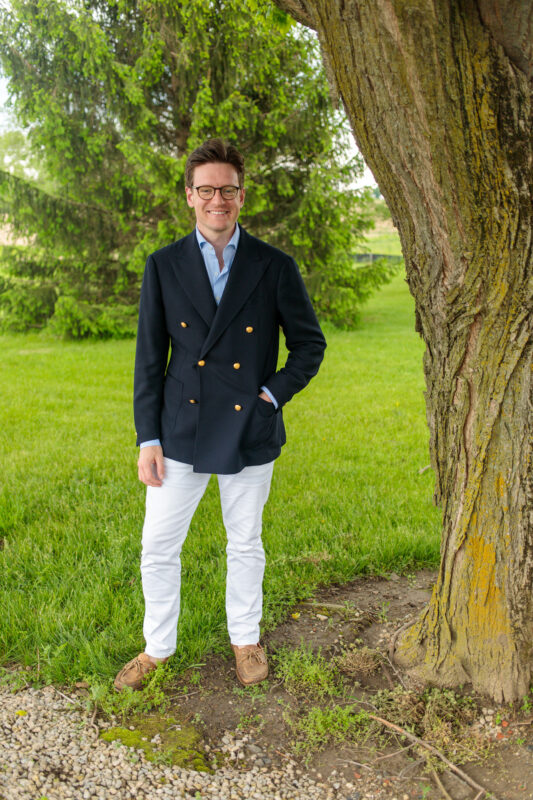
The second thing about this jacket that’s new for me is the fullness of the chest. Like with other aspects of a tailored jacket, there is a range for each guy for what constitutes a good fit in the chest of a jacket; and outside that range is objectively bad, but within that range it comes down to preference and style choices.
A more form-fitted, cleaner chest is what most would consider “correct.” In the pursuit of an ever better-fitting jacket, many size down too much and the chest is too tight causing the lapels to bulge outward. But this is a mistake: a jacket’s lapels should lie flat, even if the chest is more fitted. On the other end of the spectrum is a chest that has a bit of extra fabric, so if you touch the jacket, there is a bit of space between the fabric and your chest. Many bespoke aficionados love this type of chest, called a “drape” chest, for its comfort and style. With a slimmed waist, a fuller-fitting chest accentuates the top of your physique (along with your shoulders) and creates that inverted triangle from shoulder to waist.

This Ring Jacket definitely falls into the “drape chest” category. While some of my other jackets have a bit of room in the chest, this is definitely fuller than any of them. And you know what? It looks flattering, and it’s comfortable.
In the past, I’ve erred on the form-fitting side much more. But when I look at some of the most stylish men and how their clothes fit, I see a lot more room in the garments, allowing for the cloth to drape more. Particularly in the colder months, when fabrics are heavier, a looser fit allows them to take on a life of their own. That said, I grew up seeing lots of poorly fitting suit jackets and baggy trousers, and have a strongly negative association with them. Getting a look that’s intentionally loose without veering into that ditch is the biggest challenge for me. Generally speaking, my taste for softer, more Neapolitan (or these days, frankly, probably more Tuscan) style protects me from that—the worst offenders in baggy, badly fitting garments are cheap, mass produced things made by companies without any pedigree in real style, or at best are diffusion lines made to low standards (Lauren RL anyone?).
In a follow- post, I’ll write about pants and how they fit with a couple specific insights into how to get a better fit with tailored trousers.
In the meantime, what do you think of this Ring Jacket blazer I picked up earlier this year? Does it appear too large on my frame to you? Or does it look flattering, comfortable and stylish? Let me know below.


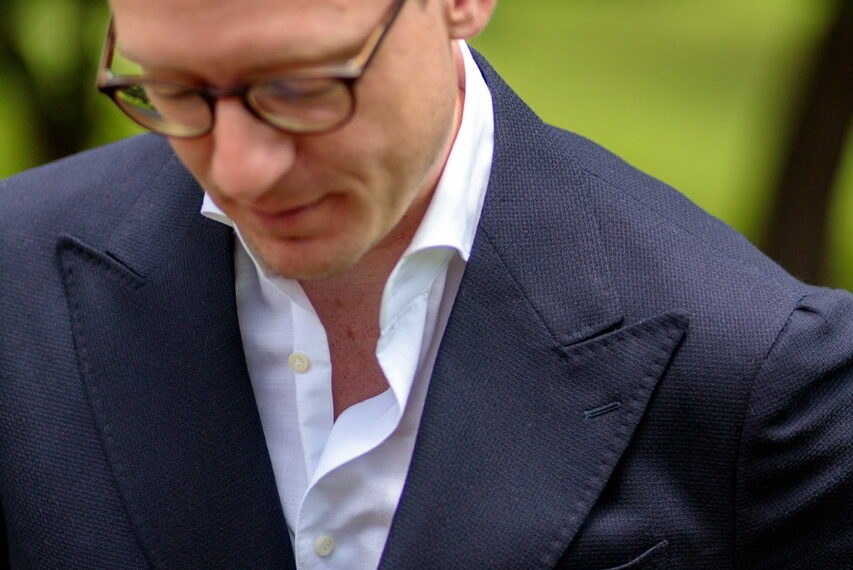
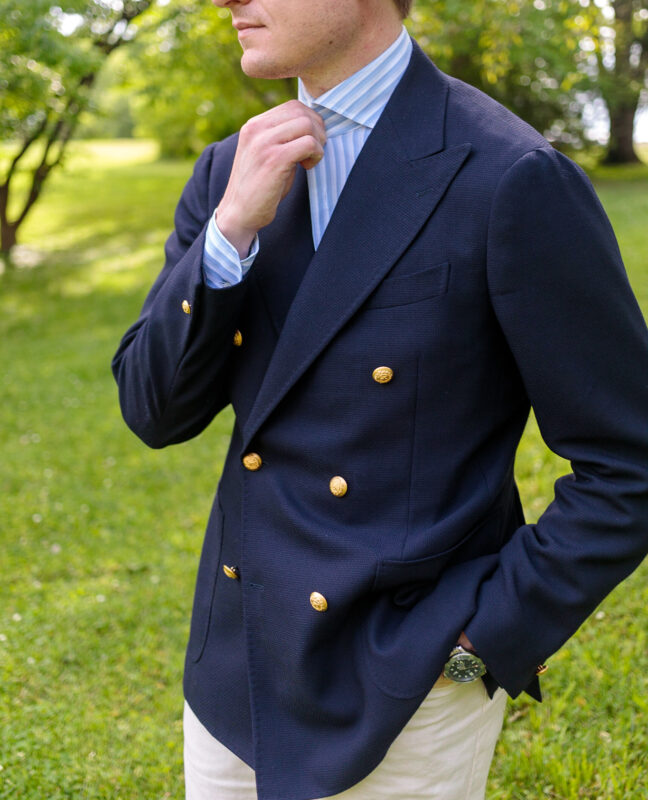
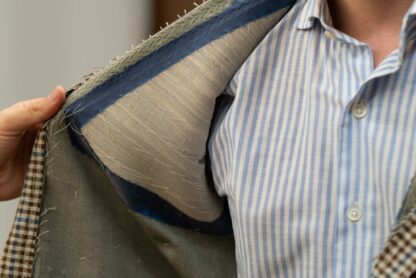

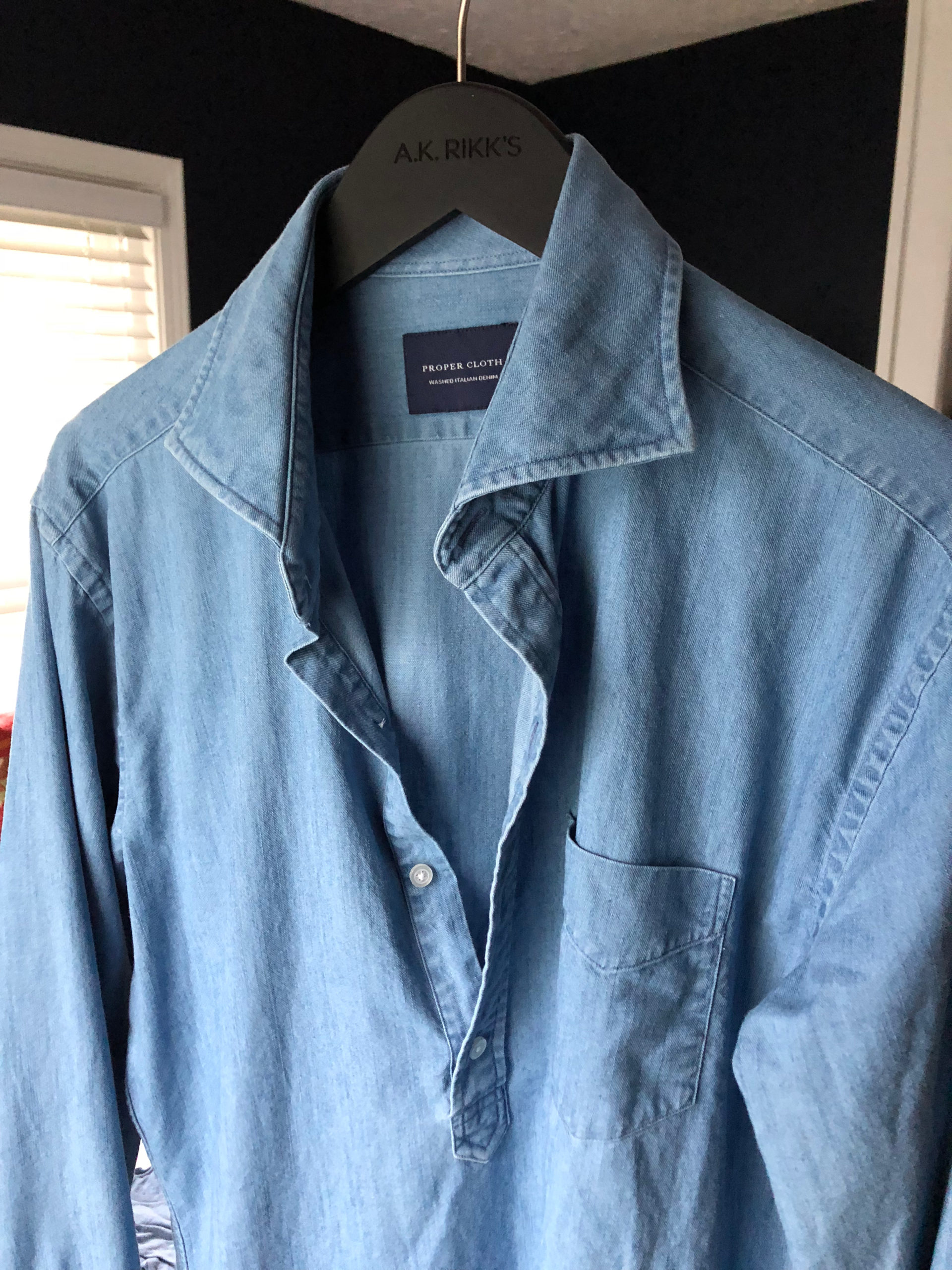
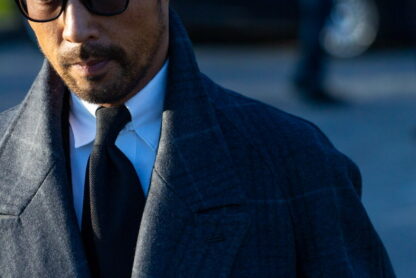

Good post. One question: with the bigger size, do you notice some fabric bunch up in your underarms, particularly when viewed from the side? That bothers me with bigger-than-average jackets I’ve tried on. I think the navy DB looks great–the gold buttons are a great ivy touch. Can be worn with a tie and tailored trousers, or unbuttoned with a beat-up OCBD and jeans. Again, nice post.
Thanks. In this case the armholes are high enough, and having the waist slimmed also brought in some extra fabric in the blades which pulled the whole thing back a little bit.
I switched the buttons for smoke MOP. The gold was too much for me though I do appreciate it. Perhaps I’d do a muted, brushed bronze instead of shiny gold. Anyways, thanks for the comment!
I have my suits and sports jackets made by my HK tailor. I would say that their house style is more English than Neopolitan but since I’m broad across the chest and shoulders (with a normal drop from chest to waist), I always emphasize a high armhole, a natural shoulder, and very little chest padding as a true “drape” cut would make me look top heavy. I think with trousers cut to fit on my natural (albeit ample) waist with a more substantial waistband and single pleat complete a balanced look for a stoutly built muddled-aged man.
Sounds awesome. Classic, even.